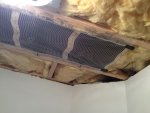Hello,
I'm newly registered, but I am familiar with a lot of your content. I recently had my first encounter with radiant ceiling heat, and the brand name is ceil heat. As you can assume, I cut the crap out of the wires. The job was to add can lights in a kitchen. This heat runs through the whole house and a lot of it is still in tact. After I discovered it, I ordered some splice kits through Raychem (name?). Anyway, they were quick to contact me and tell me that the brand is discontinued. I have already suggested Cadets, Baseboards, and best yet was a ductless system which the local jurisdiction pretty much pays for. I am waiting to hear back on cadets and baseboards, because the customer refused the ductless system. Do any of you have any experience with this nasty stuff, or have knowledge of a distributor that may carry the brand "ceil-heat" heating wire and shrink wrap splice kits for it?
Thanks,
Josh
I'm newly registered, but I am familiar with a lot of your content. I recently had my first encounter with radiant ceiling heat, and the brand name is ceil heat. As you can assume, I cut the crap out of the wires. The job was to add can lights in a kitchen. This heat runs through the whole house and a lot of it is still in tact. After I discovered it, I ordered some splice kits through Raychem (name?). Anyway, they were quick to contact me and tell me that the brand is discontinued. I have already suggested Cadets, Baseboards, and best yet was a ductless system which the local jurisdiction pretty much pays for. I am waiting to hear back on cadets and baseboards, because the customer refused the ductless system. Do any of you have any experience with this nasty stuff, or have knowledge of a distributor that may carry the brand "ceil-heat" heating wire and shrink wrap splice kits for it?
Thanks,
Josh


